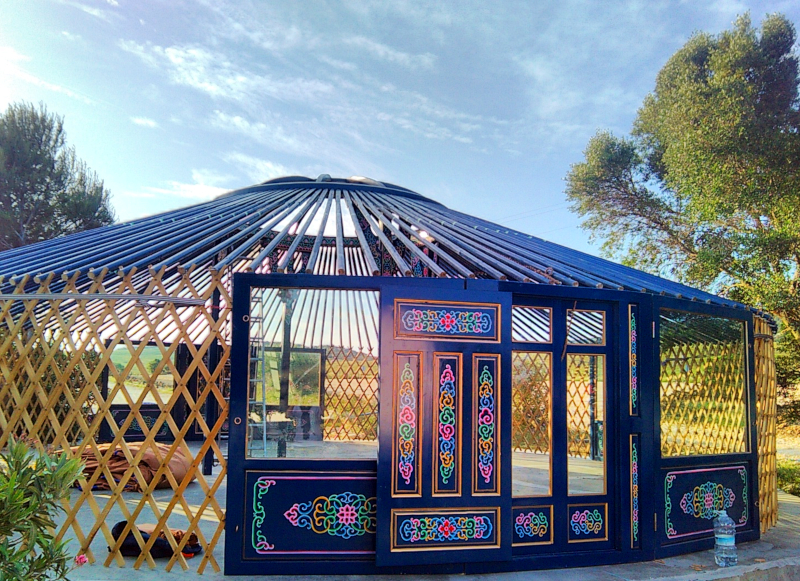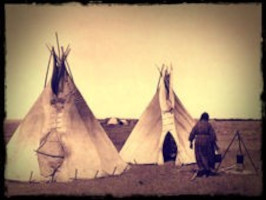What is a tepee?
The best definition of a tepee is offered by its meaning in the Lakota language: To live…
The tepee is an art form, of the art of living, which distinguishes from the other nomadic tribes to those of the natives of the Great Prairies…
Not all conical tents are tepees. Conical tents have been used for centuries in America and other places, such as Siberia. But the real tepee is distinguished from these by 2 main features:
-The tepee is a displaced cone, not symmetrical, resulting in a practical aspect to place the fire inside and allow the chimney to not be intercepted by the mass of sticks on the top…
-The hole that allows the exit of the smoke, has two large wings (smokeflaps) or flags that allow to handle the exit of the smoke efficiently depending on the weather: wind, rain, etc… helping to keep it always dry.
Tepees are only for natives?
We share the opinion that one does not have to be a Native American to respect and enjoy what the natives have built, in the same way that we consider it is not necessary to be Hindu, to respect and enjoy the benefits of the exercise of yoga. It is time to integrate…
Possibly the fact of not belonging to a particular tribe, gives us the possibility of relating to the tepee, in the way that seems best, integrating different traditions.
What design do TipiWakan tepees have?
We manufacture tepees based on the original Lakota design (we also make designs from other tribes on request)
Inspired by the creativity principles of Native Americans, our tepees include beauty and practicality in equal parts. We have adapted the original design to our times including modern mooring systems, reinforcements in key areas, tarpaulins treated to deal with environmental conditions, accessories, etc. in order to provide comfort and durability to the teepee.
The teepee can be assembled all year?
Definitely a teepee can be assembled all year. We work with high quality tarpaulins, resistant to rain, sun, mold, fire, etc. that allow permanent mounting of the tepee. However, we will advise you to perform some maintenance tasks that will improve the overall performance of the tepee as permanent housing.
How long does a teepee last?
Because the durability of a teepee as it is a natural material exposed to the weather, depends on its quality, the variable weather conditions and the use and care of its owner, it is not possible to stipulate a lifetime. of the tepee in a guaranteed way.
However, we can say that many of our tepees are permanently mounted in good condition for more than 7 years. If the tepee is disassembled when not in use, maintenance is carried out according to its climate and is stored in good condition, this end can be doubled… and more!
Is a teepee waterproof?
Due to its semi-conical shape (which repels water outwards) the resistant tarps we work with (that have waterproof treatment) and the use of a rain accessory (for the eventual water that can slide through the sticks in case of storms) the tepee can be considered waterproof.
The tepee resists strong winds?
The tepee resists strong winds since its design is based on a tripod, which is one of the most stable structures that exist.
If it will be mounted in an area with strong winds, there are some extra, simple and very effective precautions that we recommend adopting in the assembly dossier that accompanies each tepee we deliver.
Can I make fire in the teepee?
Absolutely! You can make open fire in the center of the teepee or use a fireplace. This fire besides offering a warm temperature, illuminates and offers the option of cooking in it.
What is the inner canvas?
An inner canvas, also known as a skirt or linning, is an inner canvas wall that runs along the lower part of the teepee.
Its function is to isolate and control the air flow that the tepee receives, that is, it creates a completely natural air circulation system, which benefits the central fire throw.
In TipiWakan we offer you interior canvases of various heights, with synthetic hems, pockets for storing light objects, etc.
What is the ozan?
The ozan is a half-moon-shaped interior ceiling that covers the back of the teepee, behind the fire. It serves to expel to the outside of the area of the bed, the drops that can seep between the sticks. The ozan creates a warmer and more protected microclimate in the posterior area of the tepee.
In TipiWakan we also offer a 3/4 ozan that reaches the front of the tepee, for use with a fireplace or with open fire.
What is the difference between varnished sticks and natural sticks?
You can mount a teepee with 100% natural sticks, just as we deliver them in our complete teepees. These sticks will last for years providing good use. However, to preserve the natural color of the wood, and all its qualities for more years you can choose to varnish the sticks with a special ecological varnish, like the one we use.
We can take care of this task, and we also sand and refine the tips of the sticks at the time of varnish.
Can tepees be painted?
Tepees can be decorated with authentic native designs or other interesting ones. We have a team specialized in tepees painting. If you want to paint the tepee by yourself we also offer you special acrylic paint to paint tepees, resistant to moisture and UV rays.
What is done for the ground in a tepee?
The simplest and most rustic solution for a tepee’s floor is simply the use of the surface where it is mounted.
However, various types of floor insulators can be used, which make it much more comfortable.
Carpets, wooden pallets, skins, tarpaulins … we offer you some of these options.
How long does it take to get my tepee ready?
The average time for preparing a complete medium tepee from the moment you confirm the order until the moment when it is ready for delivery, is approximately 2 weeks, but this depends on the time of the year. Contact us for more information!














